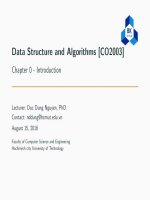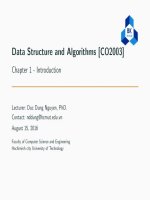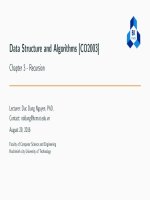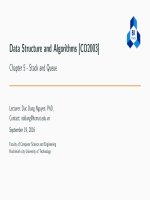C++ programming program design including data structure 7th ch14
Bạn đang xem bản rút gọn của tài liệu. Xem và tải ngay bản đầy đủ của tài liệu tại đây (160.08 KB, 30 trang )
Chapter 14:
Exception Handling
Objectives
•
In this chapter, you will:
–
–
–
–
–
Learn what an exception is
Learn how to handle exceptions within a program
Learn how a try/catch block is used to handle exceptions
Learn how to throw an exception
Become familiar with C++ exception classes and how to use them in a program
C++ Programming: Program Design Including Data Structures, Seventh Edition
2
Objectives (cont’d.)
–
–
–
–
Learn how to create your own exception classes
Discover how to throw and rethrow an exception
Explore exception handling techniques
Explore stack unwinding
C++ Programming: Program Design Including Data Structures, Seventh Edition
3
Introduction
•
•
Exception: undesirable event detectable during program execution
Code to handle exceptions depends on the type of application being developed
•
•
May or may not want the program to terminate when an exception occurs
Can add exception-handling code at point where an error can occur
C++ Programming: Program Design Including Data Structures, Seventh Edition
4
Handling Exceptions Within a Program
•
Assert function:
–
–
•
Checks if an expression meets certain condition(s)
If conditions are not met, it terminates the program
Example: division by 0
–
If divisor is zero, assert terminates the program with an error message
C++ Programming: Program Design Including Data Structures, Seventh Edition
5
C++ Mechanisms
of Exception Handling
•
•
•
try/catch block: used to handle exceptions
Exception must be thrown in a try block and caught by a catch block
C++ provides support to handle exceptions via a hierarchy of classes
C++ Programming: Program Design Including Data Structures, Seventh Edition
6
try/catch Block
•
•
•
Statements that may generate an exception are placed in a try block
The try block also contains statements that should not be executed if an exception occurs
try block is followed by one or more catch blocks
C++ Programming: Program Design Including Data Structures, Seventh Edition
7
try/catch Block (cont’d.)
C++ Programming: Program Design Including Data Structures, Seventh Edition
8
try/catch Block (cont’d.)
•
catch block:
–
–
•
Contains an exception handler
If the heading of a catch block contains ... (ellipses) in place of parameters
–
•
Specifies the type of exception it can catch
Block can catch exceptions of all types
If no exception is thrown in a try block
–
–
All catch blocks are ignored
Execution resumes after the last catch block
C++ Programming: Program Design Including Data Structures, Seventh Edition
9
try/catch Block (cont’d.)
•
If an exception is thrown in a try block
–
•
Remaining statements (in block) are ignored
Program searches catch blocks in order, looking for an appropriate exception handler
–
If the type of thrown exception matches the parameter type in one of the catch blocks:
•
•
Code of that catch block executes
Remaining catch blocks are ignored
C++ Programming: Program Design Including Data Structures, Seventh Edition
10
try/catch Block (cont’d.)
•
A catch block can have at most one catch block parameter
–
catch block parameter becomes a placeholder for the value thrown
C++ Programming: Program Design Including Data Structures, Seventh Edition
11
Throwing an Exception
•
•
For try/catch to work, the exception must be thrown in the try block
General syntax:
throw exception;
where expression is a constant value, variable, or object
•
•
Object being thrown can be a specific object or an anonymous object
In C++, an exception is a value
C++ Programming: Program Design Including Data Structures, Seventh Edition
12
Order of catch Blocks
•
catch block can catch:
–
–
•
All types of exceptions
A catch block with an ellipsis (. . .) catches any type of exception
–
•
All exceptions of a specific type
If used, it should be the last catch block of that sequence
Be careful about the order in which you list catch blocks
C++ Programming: Program Design Including Data Structures, Seventh Edition
13
Using C++ Exception Classes
•
•
C++ provides support to handle exceptions via a hierarchy of classes
what function: returns a string containing the exception object thrown by C++’s built-in
exception classes
•
class exception: base class of the exception classes provided by C++
–
Contained in the header file exception
C++ Programming: Program Design Including Data Structures, Seventh Edition
14
Using C++ Exception Classes (cont’d.)
•
Two subclasses of exception (defined in stdexcept):
–
logic_error includes subclasses:
•
•
•
–
invalid_argument: for use when illegal arguments are used in a function call
out_of_range: string subscript out of range error
length_error: if a length greater than the maximum allowed for a string object is used
runtime_error includes subclasses:
•
overflow_error and underflow_error
C++ Programming: Program Design Including Data Structures, Seventh Edition
15
Creating Your Own Exception Classes
•
Can create your own exception classes to handle specific exceptions
–
•
•
C++ uses the same mechanism to process these exceptions
throw statement: used to throw your own exceptions
Any class can be an exception class
–
How you use the class makes it an exception class
C++ Programming: Program Design Including Data Structures, Seventh Edition
16
Creating Your Own Exception Classes (cont’d.)
•
Exception class with member variables typically includes:
–
–
Constructors
The function what
C++ Programming: Program Design Including Data Structures, Seventh Edition
17
Rethrowing and Throwing an Exception
•
When an exception occurs in a try block, control immediately passes to one of the
catch blocks, which either:
–
–
•
Handles the exception, or partially processes the exception, then rethrows the same exception
Rethrows another exception for the calling environment to handle
This allows you to provide exception-handling code all in one place
C++ Programming: Program Design Including Data Structures, Seventh Edition
18
Rethrowing and Throwing an Exception (cont’d.)
•
Syntax to rethrow an exception caught by a catch block:
–
–
If the same exception is to be rethrown:
If a different exception is to be thrown
where expression is a constant value, variable, or object
C++ Programming: Program Design Including Data Structures, Seventh Edition
19
Rethrowing and Throwing an Exception (cont’d.)
•
Object being thrown can be:
–
–
•
A specific object
An anonymous object
A function specifies the exceptions it throws in its heading using the throw clause
C++ Programming: Program Design Including Data Structures, Seventh Edition
20
Exception-Handling Techniques
•
When an exception occurs, the programmer usually has three choices:
–
–
–
Terminate the program
Include code to recover from the exception
Log the error and continue
C++ Programming: Program Design Including Data Structures, Seventh Edition
21
Terminate the Program
•
•
In some cases, it is best to terminate the program when an exception occurs
Example: if an input file does not exist when the program executes
–
–
There is no point in continuing with the program
Program can output an appropriate error message and terminate
C++ Programming: Program Design Including Data Structures, Seventh Edition
22
Fix the Error and Continue
•
•
In some cases, you will want to handle the exception and let the program continue
Example: a user inputs a letter instead of a number
–
–
The input stream will enter the fail state
Can include the necessary code to keep prompting the user to input a number until the entry is valid
C++ Programming: Program Design Including Data Structures, Seventh Edition
23
Log the Error and Continue
•
Example: if the program is designed to run a nuclear reactor or continuously monitor a
satellite
–
•
It cannot be terminated if an exception occurs
When an exception occurs
–
The program should write the exception into a file and continue to run
C++ Programming: Program Design Including Data Structures, Seventh Edition
24
Stack Unwinding
•
When an exception is thrown in a function, the function can do the following:
–
–
–
•
Do nothing
Partially process the exception and throw the same exception or a new exception
Throw a new exception
In each case, the function-call stack is unwound so that the exception can be caught in the
next try/catch block
C++ Programming: Program Design Including Data Structures, Seventh Edition
25









